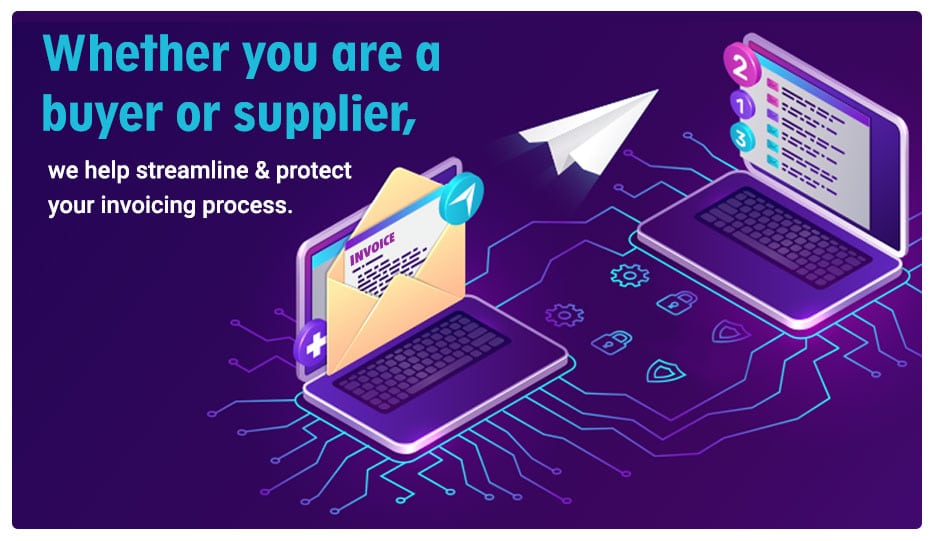
Secure Your Billing Process From Invoice Fraud
Invoice Fraud is a type of cyber attack which is fast gaining notoriety, causing huge losses to all organizations.

What Is Invoice Fraud?
Invoice fraud is a type of Business Email Compromise (BEC) which is causing all corporations big and small billions in losses. An invoice fraud occurs when cyber criminals inject themselves into the billing process and tamper with the invoices. They can do this by one of two ways:
i. Change the bank account on a supplier’s legitimate invoice
ii. Create a copycat of the supplier’s invoice and send it to the buyer
Either way, your buyer ends up paying for an illegal invoice not raised by the actual supplier.
What makes Invoice Fraud Stand Out?
Invoice fraud has some inherent properties which makes it noticeably different from other types of cyber-attacks. Its uniqueness sometimes makes it harder to detect, which is why cases have rocketed in the past couple of years. Some of these cases, like the one we discussed in our blog on PCMC Cyber Cell Intervention, are reversible. But for the most part, invoice manipulation goes unnoticed until it is too late.
Factors which makes Invoice Fraud different:
1. Heavy Social Engineering
This is a characteristic typical to BEC attacks. However, in invoice fraud, the reliance on social engineering is very high. The hacker monitors the email correspondence between two organizations: a buyer and supplier. He/she carefully assimilates the behavior and language of communications. The attacker also studies the time periods when a supplier usually sends out invoices. It is also necessary at this stage to identify which employees are holding the keys to the funds. When the time is right, the hacker gets hold of an official invoice, tampers with it, and then sends it to a buyer with a spoofed email address.
2. No Fake Links
This factor renders most email security applications ineffective in the face of duplicate invoices. There is no use of fake links or malware-infused email attachments. Everything looks on the up and up. Even if a scanner scans an email, it just makes out what kind of attachment it is, and allows it to pass through. Little does it know that the innocent looking invoice attachment has been altered in transit.
3. No payload
An invoice fraud attack takes zero coding. Email attachments do not have any scripts or macros or malicious payloads attached to them. This type of an attack depends on changing the contents of a file rather than appending malware to it.
These factors make fake bill attacks really sneaky. The attackers rely on trust between two businessmen and on careful planning to execute their attacks. However, there are certain warnings that just might alert you to an invoice fraud.
Tell Tale Signs of Invoice Fraud
1. The emails demand secrecy
Fraud invoices are often supplied with a request for privacy. The email might say, ‘Please do not disclose the release of the funds to other employers…’ or something along those lines. Because payments are a sensitive topic, the victim is likely to comply.
2. Problems with the addresses in the email address
The reply-to address and the from address in such fake emails are different. The reply-to email address might be the attacker’s own spoofed address. The reason being simple: in case you reply to an authentic email address saying you have completed the transfer, the actual person being impersonated gets alerted to the suspicious activity.
3. Creating an Urgency
The tone of the email is such that the fraudster always tries to create an urgency for the payment – “Pay the amount today”. You could observe the communication is some what different than the usual and its stress more on clearing the payment immediately.
Logix Infosecurity’s Email Auto Protect
Does keeping a lookout for the warning signs mean you remain free of invoice fraud attempts? Unfortunately, not. As we discussed, these types of attack are meticulously engineered. They are designed to slip through the cracks. Besides, as your business grows and your vendor list gets larger, you may have to deal with hundreds of invoices every month. How do you make sure your payment process is secured?
That is why we have launched a new service: Email Auto Protect. Your one stop solution for all invoicing worries.
How does Email Auto Protect work?
1. Logix’s Rights protected gateways route all the invoices intended for a buyer . In this process, our gateways block fraudulent invoices from further processing.
2. Only the person intended recipient can open the invoice.
3. Once at the appropriate buyer recipient, the invoice attachment only opens via the service’s own document handler. The recipient cannot print it through an application, but only through a physical printer. Hence, no chance of watermark removal.
4. The invoice has read-only access only and an intruder or some ‘man-in-the-middle’ has no chance of editing out the bank account number or other details.
5. Our tool watermarks all invoices going out from the supplier.
As a supplier, whether you send invoices through your billing software or through emails, we ensure that only legitimate invoices pass through.
As a buyer, the invoice fraud protection tool guarantees only valid invoices.
More details are present on our Email Auto Protect Service Page. We are also offering a launch bonus wherein you get a FREE trial of the product by registering. Just fill out the form on the service page, and our team will arrange the rest. With our tool, and a little bit of protocol streamlining, you can bid farewell to all payment clearing tensions!